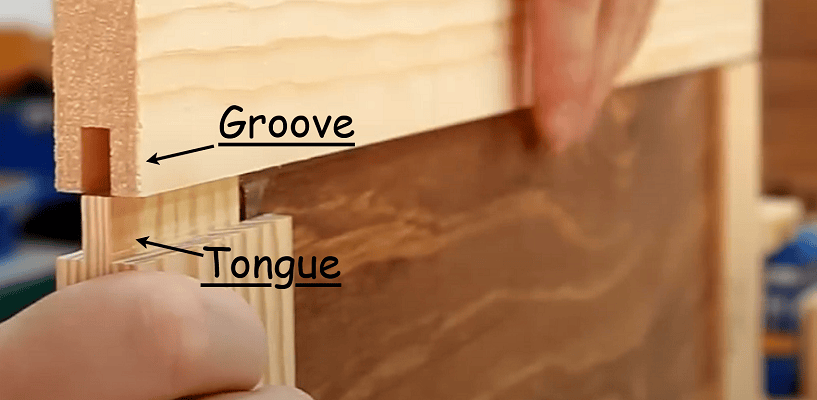- ॐ, Home
- >>
- US
- >>
- Lifestyle
- >>
- Construction
- >>
- Tongue and Groove
Tongue and Groove

This interlocking design not only enhances the structural integrity of the installation but also provides a ‘clean, aesthetically pleasing’ finish. The interlocking design provides a sturdy joint that resists pulling apart, making it ideal for ‘flooring, parquetry, paneling, decking and similar buildup.’
This method prevents gaps, enhances stability, and allows for slight ‘expansion and contraction’ of the wood due to changes in temperature and humidity. This simple yet ingenious method of joining wood has been used for “centuries,” and its popularity shows no signs of waning.
Whether you’re working on ‘flooring, wall paneling, ceilings, or even cabinetry,’ tongue and groove boards provide a seamless and sturdy fit.
“Tongue and groove” is commonly abbreviated as T&G, especially in contexts like price tags, shelf labels, product descriptions, and ‘construction or woodworking’ specifications.
Working -
How ‘tongue and groove’ works:
- Groove (or Dado): A slot is cut along the edge of one board, running the entire length.
- Tongue: A protruding ridge is cut on the opposite edge of the adjacent board by cutting away extra material. The tongue/ridge is shaped to be slightly smaller than the groove to allow for a snug fit without being too tight.
- Fit: When the tongue of one board is inserted into the groove of another, the pieces fit together closely, creating a ‘seamless and stable’ connection.
Tongue formation:
- Table Saw or Router: A table saw with a dado blade or ‘a router with a straight bit’ can be used to cut away material from both sides of the edge, forming the tongue.
- Router with a Rabbeting Bit: A router can cut precise tongues by adjusting depth and width.
- Joinery Planes: Traditional woodworkers might use ‘a rabbet or shoulder plane’ to shape the tongue precisely.
Groove formation:
- The groove is typically cut using ‘a dado blade on a table saw,’ a router with a slot-cutting bit, or ‘even a grooving plane in hand-tool woodworking.’
Common materials:
- Solid Wood: Traditional choice for T&G joints, offering natural beauty and durability.
- Engineered Wood: Often used for flooring, as it is more stable and less prone to ‘expansion and contraction.’
- MDF or Plywood: Sometimes used for ‘paneling or furniture,’ especially when painted.
Why glue is typically avoided:
- Wood Movement: Wood naturally “expands and contracts” with changes in humidity and temperature. If the joint were glued, this movement could cause stress, potentially leading to ‘the tongue breaking off’ or the wood cracks.
- Flexibility: Without glue, the joint can accommodate minor shifts in the wood, maintaining its integrity over time.
Applications where glue might be used:
- Small Projects: For items like “cutting boards” or small furniture pieces, glue might be used because the pieces are less prone to significant movement.
- Stabilized Wood: If the wood is highly stable (e.g., ‘engineered wood’ or properly dried hardwood), glue can be used to reinforce the joint.
Advantages and Applications -
Benefits of ‘tongue and groove’:
- Seamless Fit: The interlocking design eliminates visible gaps, giving surfaces ‘a clean and polished look.’
- Strength and Stability: The tight connection between boards prevents ‘warping, twisting, and separation’ over time. This makes it an excellent choice ‘for high-traffic areas like flooring’ or for exterior applications such as siding.
- Ease of Installation: Compared to other methods, ‘tongue and groove’ boards are relatively easy to install with surface, often requiring only “nails or adhesives.”
- Enhanced Aesthetics: The uniform look of T&G adds charm and sophistication to any space, whether ‘modern or rustic.’
- Versatility: This joinery method is used in various applications, from flooring and ceilings to ‘wainscoting and cabinetry.’
Common applications of ‘tongue and groove’:
- Flooring: One of the most common uses, T&G flooring provides ‘a smooth, durable surface’ while allowing for natural expansion and contraction.
- Wall Paneling: Often seen in traditional and farmhouse-style homes, ‘tongue and groove’ wall paneling adds texture and warmth to interiors.
- Cabinetry and Furniture: T&G joinery is frequently used in furniture construction to ensure ‘solid, lasting’ connections.
- Ceilings: Exposed wooden ceilings with T&G boards create ‘a cozy, elegant’ ambiance.
- Decking: Some outdoor decks utilize T&G boards to reduce gaps and create ‘a smooth, finished’ surface.
How to -
Tips for working with ‘tongue and groove’:
- Choose Your Material: Common woods for T&G include “pine, cedar, oak, and even engineered wood products.”
- Acclimate the Wood: Allow the boards to adjust to the room’s humidity and temperature for at least 48 hours before installation.
- Prepare the Surface: Ensure that the “subfloor, wall, or ceiling” is ‘clean, dry, and level.’
- Start from One Side: Begin installing the first board with its groove side facing the ‘wall or starting edge.’ This allows the tongue of the next board to fit into the groove of the first board.
- Secure the Boards: Attach each board to the surface using “nails, screws, or adhesives.”
- Continue Across the Surface: Work your way across the surface, installing one board at a time. Ensure each board is aligned and fits tightly with the previous one. Use ‘a rubber mallet or tapping block’ to gently adjust the boards if needed.
- Finish as Desired: ‘Stain, paint, or seal’ the boards to enhance durability and aesthetics.
That’s all friends.
Suggestions or corrections for this page can be submitted from the “contact us” page.
Ads Section

